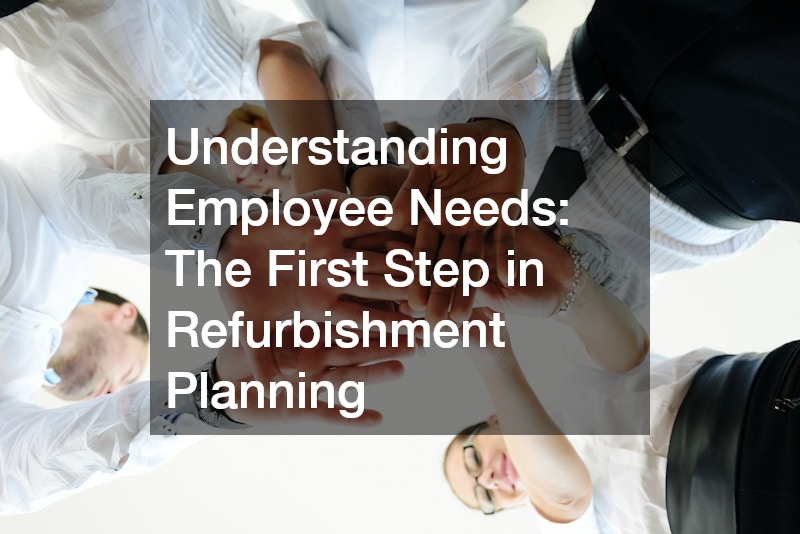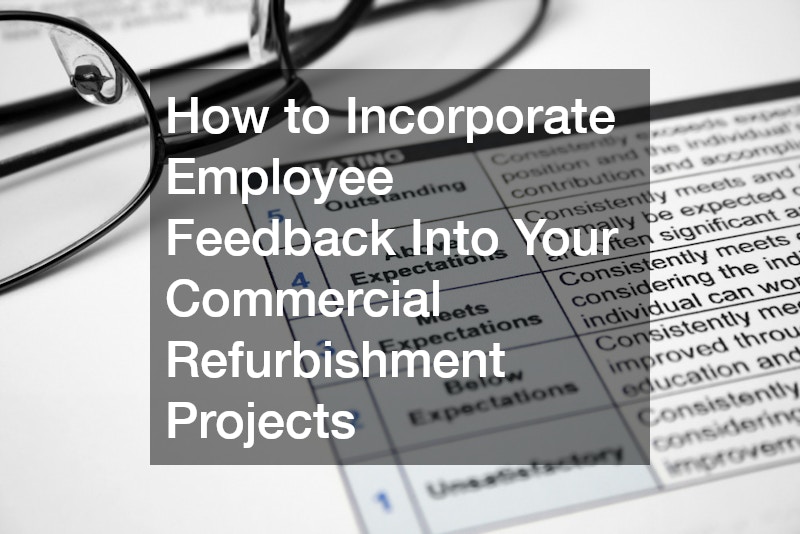Refurbishing a commercial space requires a comprehensive understanding of both the physical and emotional needs of the employees who occupy it. The process of commercial refurbishment goes beyond mere physical alterations; it involves a strategic approach to improving functionality, aesthetics, and overall workplace satisfaction. This article explores how a focus on employee input can guide a successful refurbishment project, incorporating elements like design, amenities, sustainability, and practicality.
Commercial refurbishment projects not only impact the physical environment of a workspace but also influence employee productivity, comfort, and satisfaction. This makes it imperative for planners to involve employees in the decision-making process. By addressing the needs of those who use the space daily, organizations can ensure a more effective and efficient outcome.
Throughout this article, we will examine the critical aspects of involving employees in the planning and execution stages of office updates. By integrating feedback through surveys, interviews, and discussions, organizations can create workspaces that enhance both operational efficiency and employee morale.
Understanding Employee Needs: The First Step in Refurbishment Planning

Understanding employee needs is crucial when embarking on a commercial refurbishment project. Employees are the primary users of office spaces, and their satisfaction can significantly influence productivity and morale. A tailored approach that prioritizes their comfort and efficiency leads to impactful improvements.
The first step in assessing employee needs is to clearly identify how different groups within the organization utilize their space. This involves understanding the unique requirements of various departments or roles. For instance, open spaces might benefit creative teams who thrive on collaboration, while private zones might be more suitable for roles requiring concentration.
Recognizing these diverse needs ensures that a refurbishment project will be inclusive and supportive of various working styles. Collaboration with employees for insights can reveal areas that need attention and solutions that can be implemented to meet these needs. Moreover, involving employees in the early stages fosters a sense of ownership and engagement in the refurbishment process.
Utilizing Surveys and Interviews for Valuable Insights

The use of surveys and interviews is an effective strategy for gathering crucial insights during a commercial refurbishment. Surveys can be distributed across the organization to collect data on employee preferences, experiences, and suggestions for improvements. They provide a structured way to gather quantitative feedback from a broad employee base.
On the other hand, interviews offer an opportunity to delve deeper into specific issues employees might be facing. By conducting one-on-one sessions, planners can gather qualitative data that helps identify particular challenges or desires employees may have regarding their workspace. This tailored approach allows for richer, more nuanced insights that can guide refurbishment decisions.
Combining both surveys and interviews ensures a comprehensive understanding of employee perspectives. This dual-method approach facilitates the collection of actionable insights that can lead to thoughtful and effective design solutions. Engaging with employees through these means ensures that the refurbishment aligns with their needs and expectations.
How to Facilitate Open Discussions About Workspace Improvements

Facilitating open discussions about workspace improvements is critical to fostering a culture of transparency and inclusivity during a commercial refurbishment. One effective method is to host regular forums or town hall meetings where employees can voice their opinions. Creating a safe and open environment for discussion invites honest feedback that can be invaluable in shaping design decisions.
These discussions should be framed as collaborative sessions where employees feel empowered to suggest ideas and express concerns. By allowing all voices to be heard, organizations can identify common themes and areas for improvement. Moreover, these gatherings are an opportunity to communicate the goals and benefits of the refurbishment, reinforcing employee participation and enthusiasm.
To maximize participation, it is essential to establish clear channels for ongoing communication. This can include dedicated email addresses, feedback forms, or online forums where employees can share thoughts and updates at their convenience. Continuous engagement helps create a sense of investment in the project’s success.
Collaborating with Experts for Feedback on Design Choices

Consulting with industry experts is an essential step in executing a successful commercial refurbishment. Professionals such as interior designers, architects, and engineers bring expertise that can refine design choices and ensure they meet professional standards. Their experience can help translate employee feedback into practical and aesthetically pleasing solutions.
Engaging with specialists ensures that technical aspects such as structural integrity, safety regulations, and environmental considerations are addressed. By collaborating with experts, businesses can ensure that their refurbishment plans are both innovative and compliant. This professional guidance is crucial, especially when integrating complex systems like those offered by metal roofing services or local backup generator services.
Furthermore, specialists from sectors such as commercial roofers and commercial glass companies provide insights into materials and construction methods that can enhance durability and sustainability. Their collaboration is a testament to an organization’s commitment to quality refurbishment that stands the test of time while meeting employees’ needs.
The Importance of Considering Functionality in Office Layouts
The functionality of an office layout is a vital factor in the commercial refurbishment process. An effective layout should accommodate various functions and activities seamlessly, allowing for flexibility and efficiency within the workspace. Areas like meeting rooms, workstations, and relaxation zones should be strategically designed to support diverse work styles.
Efforts to prioritize functionality can lead to enhanced workflow and communication among employees. For instance, incorporating multifunctional furniture or adaptable spaces can allow teams to reconfigure their environments quickly based on the task at hand. These considerations not only improve day-to-day operations but also cater to future expansion needs.
By aligning layout designs with employee usage patterns, businesses can ensure that their office spaces promote productivity and reduce distractions. This approach underscores the importance of a thoughtful design that balances aesthetics with practical needs, contributing to the overall success and efficiency of the refurbishment project.
Gathering Input on Essential Amenities and Services
Identifying essential amenities and services is a critical aspect of commercial refurbishment. Employees’ input on what facilities are most necessary can significantly influence their satisfaction and productivity. Common requests might include updated kitchen areas, advanced technological infrastructure, ergonomic furniture, or recreation spaces.
It is vital to consider the diversity of amenities required by different departments or teams within the organization. While some roles may necessitate specialized equipment or quiet zones, others might benefit from collaboration tools or flexible workspace arrangements. Tailoring amenity offerings can effectively support the varied needs of the workforce.
The integration of services like 24 hour emergency plumbing service ensures that the workspace remains functional at all times, contributing to business continuity and employee well-being. When employees feel that their practical needs are met, they are more likely to feel valued and engaged in their work environment.
How Employee Feedback Can Guide Choices in Materials and Finishes
Employee feedback is invaluable in guiding choices concerning materials and finishes in a commercial refurbishment project. Their preferences and insights can help determine which materials best accommodate their needs for comfort, durability, and aesthetic appeal. This input becomes a significant factor when selecting elements that align with the company’s culture and brand identity.
By understanding what employees value in their workspace, planners can make informed decisions about materials. For instance, if sound reduction is a priority, acoustic paneling might be favored, whereas high-traffic areas might benefit from durable industrial carpets. Feedback can also inform lighting options, paint colors, and other finishes, ensuring that they contribute to a positive working environment.
Incorporating employee preferences in these decisions not only enhances satisfaction but also ensures practical considerations, such as maintenance and longevity, are accounted for. Choice materials from commercial floor coating companies reflect a commitment to creating a workspace that is functional, safe, and visually appealing.
Ensuring Comfort: Discussing HVAC Needs and Preferences
The comfort of a workplace is significantly influenced by its heating, ventilation, and air conditioning (HVAC) systems. Ensuring that these systems meet employee needs and preferences is a key element in any commercial refurbishment. Comfort levels can impact productivity and well-being, making HVAC decisions crucial.
Discussions with employees about their experiences with current HVAC systems can uncover issues like poor air quality, inefficient temperature control, or noise. Addressing these problems by working with HVAC companies not only prioritizes employee comfort but also can improve energy efficiency and reduce operational costs.
Implementing systems that allow individual temperature control or advanced air filtration can dramatically increase workplace satisfaction. When employees are comfortable, they are more likely to be focused and productive, confirming the importance of tailored HVAC solutions in an office refurbishment.
The Role of Visual Aesthetics in Employee Satisfaction
Visual aesthetics play a significant role in employee satisfaction, impacting overall mood and productivity within the workspace. A commercial refurbishment must thoughtfully balance design elements to create an environment that aligns with the company’s ethos and inspires creativity and collaboration.
Elements such as color schemes, artwork, and natural light contribute to a visually appealing workspace. By incorporating employee feedback, businesses can choose aesthetics that resonate with their team, promoting a sense of belonging and motivation. This approach is supported by adjustments like utilizing services from local commercial printing service for customized design elements.
Moreover, thoughtful design contributes to a positive brand image and can enhance employee pride in their workplace. When employees feel connected to their environment, it fosters a stronger allegiance to their organization, which is beneficial for retention and morale.
Balancing Practicality with Style in Your Refurbishment Plans
Balancing practicality with style is a crucial consideration in commercial refurbishment plans. While aesthetics are important, functionality remains the backbone of an effective workspace. Achieving the right balance requires thoughtful design that meets operational demands while reflecting the company’s brand and values.
This balance can be seen in choices like combining durable flooring solutions with elegant design elements. Collaboration with a commercial floor coating company can provide options that meet both practical needs and aesthetic goals. Similarly, combining effective layout designs with tasteful décor enhances both usability and appeal.
Incorporating style without sacrificing practicality ensures a workspace that not only looks good but also supports productivity and employee engagement. A well-rounded refurbishment plan considers both form and function, leading to a harmonious and efficient office environment.
The Benefits of Pilot Testing New Designs Before Full Implementation
Pilot testing new design concepts is a strategic approach to mitigate risks associated with commercial refurbishment. By implementing a trial phase, organizations can observe how changes impact daily operations and employee satisfaction. This allows for adjustments and refinements before full-scale deployment.
Pilot tests provide valuable feedback from employees who interact with the updated space. This firsthand experience enables planners to address unforeseen challenges and fine-tune aspects such as layout efficiency or material choice. Successful test phases can increase confidence in the overall refurbishment plan.
Moreover, pilot testing demonstrates a commitment to involving employees in the process, fostering an inclusive and collaborative culture. By prioritizing a trial period, organizations showcase their willingness to adapt and make informed decisions that benefit the entire workforce.
Incorporating Sustainable Practices Based on Employee Preferences
Sustainability is an increasingly important aspect of commercial refurbishment, reflecting both organizational values and employee preferences. Eco-friendly practices not only reduce environmental impact but also resonate with employees’ growing desire for responsible business operations.
Employees’ input can guide sustainable choices, such as selecting materials with low environmental footprints, integrating energy-efficient systems, or enhancing recycling facilities. Their involvement ensures the refurbishment aligns with their values and promotes a healthier work environment.
Partnerships with specialized services, such as commercial parking lot resurfacing with sustainable materials or eco-friendly metal roofing services, demonstrate a commitment to sustainability. By incorporating green practices, organizations can enhance their reputation and appeal to a conscientious workforce.
Engaging Employees in the Final Review of Refurbishment Plans
The final review phase of a commercial refurbishment project is crucial for ensuring success. Engaging employees at this stage allows them to voice last-minute insights or concerns, leading to a more inclusive and satisfactory outcome. Open forums or review sessions can facilitate this dialogue effectively.
By actively involving employees in the final review, organizations ensure that all perspectives have been considered, reinforcing a sense of community and shared responsibility. This phase is also an opportunity to address any unresolved issues and finalize elements with expert input, like commercial wood fencing company solutions for exterior projects.
Ultimately, employee involvement in the final review underscores their role in the refurbishment process. It builds anticipation and excitement for the new work environment, encouraging a smooth transition into the updated space. By fostering a shared vision, organizations set the stage for successful implementation and increased employee satisfaction.
Commercial refurbishment driven by employee input is a dynamic and rewarding approach to transforming office spaces. By prioritizing the needs and expectations of those who use the space daily, companies can create environments that enhance productivity, well-being, and satisfaction. Engaging employees throughout the process fosters a culture of inclusivity and shared investment in the future of the workplace.
As you know, certain services like metal roofing services and plumbers may have an effect on your workflow while they work. Fortunately, your team can work together to plan ahead. From initial planning and discussions to expert collaboration and final reviews, each stage is an opportunity to align the company’s physical environment with its values and goals. By integrating sustainability, practicality, and style, organizations can achieve a balanced refurbishment that benefits both employees and the business as a whole.
Through careful project management, leveraging feedback, and collaborating with service experts such as commercial roofers, HVAC companies, and metal roofing services, companies can confidently undertake refurbishment projects. With a focus on employee needs and preferences, commercial refurbishment can lead to workspaces that are both inspiring and functional.





